Comparison of Selected Algorithms in Movie Recommender System
Abstract
1. Introduction
2. Related Work and Current State of Recommender Systems
- Increase in item sales: A key function of commercial recommender systems is allowing the sale of additional items beyond the commonly sold ones.
- Sale of more diverse items: The system allows users to select items that may not have been visible without precise recommendations.
- Better understanding of user needs: Systems can describe the tastes and preferences of a given user.
2.1. Movie Recommender Systems
- Content-based recommender systems
- Collaborative filtering recommender systems
- Knowledge-based recommender systems
- Hybrid recommender systems
2.2. Strengths and Weaknesses of Current Recommender Systems
2.2.1. Strengths
- Personalization: Thanks to advanced technologies, these systems can offer tailored recommendations.
- Improved user experience: Users can easily encounter new and precisely suitable content through these systems.
- Increased sales and customer retention: Especially for online stores, these systems are becoming invaluable tools for boosting sales and ensuring customer loyalty.
2.2.2. Weaknesses
- Cold start problem: Without sufficient data, initial recommendations may be less accurate.
- Lack of diversity: There is a risk that systems will repeatedly offer content that users are already familiar with.
- Manipulation and bias: There is a danger that systems could be manipulated for commercial purposes.
2.3. Content-Based Recommender Systems
- Personalization: They allow users to create their own profiles based on their ratings.
- Independence from the number of users: These systems work even when extensive data from other users is not available.
- Ability to recommend new items: They can identify and recommend new or underrated products.
- Risk of over-specialization: Users may be recommended content that is too narrowly focused on their previous preferences.
- Feedback collection: It can be more difficult to gather user feedback, which is essential for improving the accuracy and relevance of recommendations.
2.4. Collaborative Filtering Recommender Systems
2.5. Hybrid Recommender Systems
- Solving the cold start problem: They effectively respond to new users or products without rating history by utilizing content-based information.
- Higher recommendation accuracy: By leveraging the strengths of both approaches, hybrid systems provide users with more accurate and relevant recommendations.
- Flexibility: They have the ability to adapt to various user needs by combining multiple data sources and methods.
3. Design and Specification of Metrics for Algorithm Comparison
3.1. Precision and Recall
- True Positive (TP)—The item was recommended and consumed by the user.
- False Positive (FP)—The item was recommended, but the user did not consume it.
- False Negative (FN)—The item was not included in the recommendations, but the user consumed it.
- True Negative (TN)—The item was not recommended, and the user did not consume it.
- Precision—What portion of the recommended items was consumed by the user.
- Recall—What proportion of all items that the user consumed was recommended.
- Precision = True Positives/(True Positives + False Positives)
- Recall = True Positives/(True Positives + False Negatives)
3.2. F1-Score
3.3. Mean Absolute Error
- ∑—The sum of all values in the dataset.
- —The actual rating given by user u for item i.
- —The predicted rating by the algorithm for user u for item i.
3.4. Mean Squared Error
- ∑—The sum, representing the sum of all values.
- —The square of the difference between the actual rating given by user u for item i and the predicted rating. The squared function emphasizes larger errors.
- ∈ —Indicates that we consider all predicted ratings from the set of predictions .
4. Implemented Recommender System Algorithms
- High data quality—The MovieLens datasets are carefully curated by GroupLens, a reputable research group at the University of Minnesota. Dataset is consistently clean, de-duplicated, and well-formatted, which minimizes preprocessing effort.
- Rich metadata—Movies are annotated with genres, titles, and in some versions timestamps, and even user demographic data (in 1 M version)
- Widely used and well documented—MovieLens is one of the most cited and used datasets in recommendation system research. That makes it easier to compare models, reproduce results, and benchmark algorithms.
- BaselineOnly algorithm—useful for quick and simple predictions, used as benchmark model.
- CoClustering algorithm—ability to provide personalized recommendations by analyzing relationships and grouping users and items into co-clusters.
- KNNBaseline algorithm—robust mechanism for enhancing recommendation accuracy within collaborative filtering.
- SVD algorithm—crucial algorithm for the development of modern recommender systems due to its ability to decompose data and uncover hidden patterns; one of the most popular collaborative filtering algorithms.
- Non-negative Matrix Factorization (NMF) algorithm—similar to SVD algorithm but restricts factors to be non-negative, producing additive (parts-based) representations; often leads to more interpretable latent factors.
- SlopeOne algorithm—collaborative filtering algorithm based on a simple derivation method from user ratings, characterized by low computational complexity and easy implementation; its ability to quickly generate reliable predictions with minimal complexity makes it an attractive option for a wide range of recommender systems.
4.1. BaselineOnly Algorithm
- is the predicted rating of user u for item i.
- is the global average of all ratings.
- Application
4.2. CoClustering Algorithm
- is the average rating in the joint cluster.
- is the average rating in the user cluster.
- is the average rating in the item cluster.
- Parameters
- n_cltr_u (int): The number of user clusters. The default value is 3.
- n_cltr_i (int): The number of item clusters. The default value is 3.
- n_epochs (int): The number of iterations for the optimization loop. The default value is 20.
- Application
4.3. KNNBaseline Algorithm
- Parameters
- k: The maximum number of neighbors considered for aggregation. The default value is 40.
- min_k: The minimum number of neighbors considered for aggregation. If there are not enough neighbors, the aggregation is set to zero. The default value is 1.
- sim_options: A dictionary of options for computing similarity measures. It is recommended to use the pearson_baseline similarity measure.
- Application
4.4. SVD Algorithm
- is the global average of all ratings.
- is the bias (deviation) of item i.
- and are the learning rate and regularization coefficient.
- Parameters
- n_factors: The number of latent factors. The default value is 100.
- n_epochs: The number of SGD iterations. The default value is 20.
- lr_all, reg_all: Global learning rate and regularization for all parameters. The default value is 0.005.
- Application
4.5. NMF Algorithm
- Parameters
- n_factors: The number of latent factors. The default value is 15.
- n_epochs: The number of iterations for the SGD procedure. The default value is 50.
- biased: Specifies whether to use biases (baseline estimates). The default value is False.
- reg_pu, reg_qi: Regularization terms for user and item latent factors. The default value is 0.06.
- Application
4.6. SlopeOne Algorithm
- is the average rating of user u.
- is the set of relevant items, i.e., the set of items j that user u has rated and that have at least one common user with item i.
- is the average difference between the ratings of item i and the ratings of item j.
- Application
5. Results
5.1. Dataset Preparation
- 100,000 ratings
- Provided by 943 users
- Up to 1682 rated movies
- Ratings range from 0.5 to 5
- The training set is used to build the model
- The test set is used to validate predictive performance on unseen data
- Errors and incomplete records (including incorrectly formatted ratings) were removed.
- The data were normalized to maintain a consistent value range for all applied algorithms.
5.2. Model Evaluation
- First, it records the occurrence count of each genre in the rated movies using a Counter data structure.
- Then, it sorts the genres in descending order based on their frequency.
| Algorithm 1: Obtaining lists of favorite and least favorite genres. |
| Require: user_ratings Require: all_genres 1: genre_counts ← Counter() 2: for genres in user_ratings[‘genres’] do 3: for genre in genres.split(‘|’) do 4: genre_counts[genre] += 1 5: sorted_genres ← sorted(all_genres, key = lambda x: genre_counts.get(x, 0), reverse = True) 6: mid_point ← len(sorted_genres)//2x 7: return sorted_genres[:mid_point], sorted_genres[mid_point:] |
- 3.
- For each recommended movie, it determines how many of its genres are favorite and how many are least favorite.
- 4.
- Relevance is then computed as the difference between the number of favorite and least favorite genres.
- 5.
- A movie is considered relevant if this difference is positive.
| Algorithm 2: Relevance of recommended movies. |
| Require: recommended_movies Require: fav_genres, unfav_genres 1: relevant_movies ← 0 2: for each row in recommended_movies do 3: genres ← row[‘genres’].split(‘|’) 4: score ← sum(1 for genre in genres if genre in fav_genres) sum(1 for genre in genres if genre in unfav_genres) 5: if score > 0 then 6: relevant_movies ← relevant_movies + 1 7: return relevant_movies |
- SVD (Singular Value Decomposition)
- CoClustering
- NMF (Non-negative Matrix Factorization)
- SlopeOne
- KNNBaseline
- BaselineOnly
| Algorithm 3: List of algorithms for comparison. |
| Require: SVD Require: CoClustering Require: NMF Require: SlopeOne Require: KNNBaseline Require: BaselineOnly 1: algorithms ← [SVD(), CoClustering(), NMF(), SlopeOne(), KNNBaseline(), BaselineOnly()] |
| Algorithm 4: Splitting the data into training and test sets. |
| Require: ratings_df Require: Reader Require: Dataset Require: train_test_split 1: reader ← Reader(rating_scale=(0.5, 5)) 2: data ← Dataset.load_from_df(ratings_df[[‘userId’, ‘movieId’, ‘rating’]], reader) 3: trainset, testset ← train_test_split(data, test_size=0.25) |
| Algorithm 5: Iteration through algorithms, training, and evaluation. |
| Require: algorithms Require: trainset Require: testset Require: time 1: for each algorithm in algorithms do 2: start_time ← time.time() 3: algorithm.fit(trainset) 4: predictions ← algorithm.test(testset) 5: end_time ← time.time() 6: eval_time ← end_time − start_time |
- uid: The user ID for whom the prediction was generated. This is the user identifier from the test set.
- iid: The movie ID for which the prediction was generated. This is the item identifier from the test set.
- r_ui: The actual rating the user gave to the movie. This value comes from the test set and is used for comparison with the predicted rating.
- est: The value predicted by the algorithm. This is the predicted rating that the algorithm generated for the given user-movie combination.
| Algorithm 6: Identification of relevant genre preferences. |
| Require: predictions Require: movies_df Require: fav_genres Require: unfav_genres Require: is_genre_relevant 1: genre_relevance_info ← [] 2: for each pred in predictions do 3: movie_id ← pred.iid 4: genres_str ← movies_df.loc[movies_df[‘movieId’] == movie_id, ‘genres’].values [0] 5: genres ← genres_str.split(‘|’) 6: is_relevant ← is_genre_relevant(genres, fav_genres, unfav_genres) 7: genre_relevance_info.append(is_relevant) 8: relevant_predictions ← [pred for pred, is_relevant in zip(predictions, genre_relevance_info) if is_relevant] |
- Precision measures how many of the recommended movies were actually relevant.
- Recall evaluates how many relevant movies were successfully recommended.
- F1-score provides a balanced measure of both metrics.
| Algorithm 7: Identification of relevant genre preferences—SVD algorithm. |
| Require: user_id Require: fav_genres Require: unfav_genres Require: precision Require: recall Require: f1_score Require: recommended_movies 1: user_id ← 77 2: fav_genres ← [‘Action’, ‘Adventure’, ‘Sci-Fi’, ‘Drama’, ‘Thriller’] 3: unfav_genres ← [‘Romance’, ‘Children’, ‘Animation’, ‘Western’, ‘Horror’] 4: precision ← 0.80 5: recall ← 0.52 6: f1_score ← 0.63 7: recommended_movies ← [ (‘Usual Suspects, The (1995)’, ‘Crime|Mystery|Thriller’), (‘Shawshank Redemption, The (1994)’, ‘Crime|Drama’), (‘Forrest Gump (1994)’, ‘Comedy|Drama|Romance|War’), (‘Dr. Strangelove or: How I Learned to Stop Worrying and Love the Bomb (1964)’, ‘Comedy|War’), (‘Godfather, The (1972)’, ‘Crime|Drama’), (‘Rear Window (1954)’, ‘Mystery|Thriller’), (‘Casablanca (1942)’, ‘Drama|Romance’), (‘Reservoir Dogs (1992)’, ‘Crime|Mystery|Thriller’), (‘Monty Python and the Holy Grail (1975)’, ‘Adventure|Comedy|Fantasy’), (‘Good, the Bad and the Ugly, The (1966)’, ‘Action|Adventure|Western’), (‘Lawrence of Arabia (1962)’, ‘Adventure|Drama|War’), (‘Apocalypse Now (1979)’, ‘Action|Drama|War’), (‘Goodfellas (1990)’, ‘Crime|Drama’), (‘Godfather: Part II, The (1974)’, ‘Crime|Drama’), (‘Fight Club (1999)’, ‘Action|Crime|Drama|Thriller’)] |
- Data preparation
- Algorithm selection
- Model training and testing
- Adjusting input data to account for user preferences
5.3. Experimental Results
6. Conclusions
6.1. Practical Implications
- An efficient part of hybrid recommender system which combines collaborative filtering and content-based approach;
- Based on its properties, it can capture underlying patterns in user preferences and item attributes;
- An efficient algorithm for implementing recommender systems in various areas.
6.2. Future Work
Author Contributions
Funding
Institutional Review Board Statement
Informed Consent Statement
Data Availability Statement
Conflicts of Interest
References
- Falk, K. Practical Recommender Systems; Manning Publications: Shelter Island, NY, USA, 2019. [Google Scholar]
- Raza, S.; Rahman, M.; Kamawal, S.; Toroghi, A.; Raval, A.; Navah, F.; Kazemeini, A. A comprehensive review of recommender systems: Transitioning from theory to practice. arXiv 2024, arXiv:2407.13699. [Google Scholar] [CrossRef]
- Goodrow, C. On YouTube’s Recommender System. YouTube Official Blog. 2021. Available online: https://blog.youtube/inside-youtube/on-youtubes-recommendation-system/ (accessed on 15 April 2025).
- Netflix. How Netflix’s Recommendations System Works. Netflix Help Center. 2023. Available online: https://help.netflix.com/en/node/100639 (accessed on 15 April 2025).
- Smith, B.; Linden, G. Two decades of recommender systems at Amazon. com. IEEE Internet Comput. 2017, 21, 12–18. [Google Scholar] [CrossRef]
- Zhou, R.; Khemmarat, S.; Gao, L. The impact of YouTube Recommender system on video views. In Proceedings of the 10th ACM SIGCOMM Conference on Internet Measurement, Melbourne, Australia, 1–3 November 2010; pp. 404–410. [Google Scholar]
- Mangalindan, J.P. Amazon’s Recommendation Secret. Fortune. 30 July 2012. Available online: https://fortune.com/2012/07/30/amazons-recommendation-secret (accessed on 15 April 2025).
- Google Ads. Google Ads–Get Customers and Sell More with Online Advertising. 2024. Available online: https://ads.google.com/ (accessed on 15 April 2025).
- Google News. 2024. Available online: https://news.google.com/topstories (accessed on 15 April 2025).
- YouTube. 2024. Available online: https://www.youtube.com (accessed on 15 April 2025).
- Azaria, A.; Hassidim, A.; Kraus, S.; Eshkol, A.; Weintraub, O.; Netanely, I. Movie recommender system for profit maximization. In Proceedings of the 7th ACM conference on Recommender systems, Hong Kong, China, 12–16 October 2013; pp. 121–128. [Google Scholar]
- McLachlan, S. How the YouTube Algorithm Works in 2023: The Complete Guide; Hootsuite: Vancouver, BC, USA, 2023. [Google Scholar]
- Millecamp, M.; Htun, N.N.; Jin, Y.; Verbert, K. Controlling spotify recommendations: Effects of personal characteristics on music recommender user interfaces. In Proceedings of the 26th Conference on User Modeling, Adaptation and Personalization, Singapore, 8–11 July 2018; pp. 101–109. [Google Scholar]
- Anandhan, A.; Shuib, L.; Ismail, M.A.; Mujtaba, G. Social media recommender systems: Review and open research issues. IEEE Access 2018, 6, 15608–15628. [Google Scholar] [CrossRef]
- Ilic, A.; Kabiljo, M. Recommending Items to More Than a Billion People. Engineering at Meta. 2018. Available online: https://engineering.fb.com/2015/06/02/core-infra/recommending-items-to-more-than-a-billion-people/ (accessed on 15 April 2025).
- Hwangbo, H.; Kim, Y.S.; Cha, K.J. Recommender system development for fashion retail e-commerce. Electron. Commer. Res. Appl. 2018, 28, 94–101. [Google Scholar] [CrossRef]
- Ahn, H.; Kim, K.J.; Han, I. Mobile advertisement recommender system using collaborative filtering: MAR-CF. In KGSF-Conference; The Korea Society of Management Information Systems: Seoul, Republic of Korea, 2006; Volume 2006, pp. 709–715. [Google Scholar]
- Broder, A.Z. Computational advertising and recommender systems. In Proceedings of the 2008 ACM Conference on Recommender Systems, Lausanne, Switzerland, 23–25 October 2008; pp. 1–2. [Google Scholar]
- Sebastia, L.; Garcia, I.; Onaindia, E.; Guzman, C. e-Tourism: A tourist recommendation and planning application. Int. J. Artif. Intell. Tools 2009, 18, 717–738. [Google Scholar] [CrossRef]
- Steinbauer, A.; Werthner, H. Consumer Behaviour in e-Tourism; Springer: Vienna, Austria, 2007; pp. 65–76. [Google Scholar]
- Darban, Z.Z.; Valipour, M.H. GHRS: Graph-based hybrid recommendation system with application to movie recommendation. Expert Syst. Appl. 2022, 200, 116850. [Google Scholar] [CrossRef]
- Lavanya, R.; Singh, U.; Tyagi, V. A comprehensive survey on movie recommendation systems. In Proceedings of the 2021 International Conference on Artificial Intelligence and Smart Systems (ICAIS), Coimbatore, India, 25–27 March 2021; pp. 532–536. [Google Scholar]
- Mu, Y.; Wu, Y. Multimodal movie recommendation system using deep learning. Mathematics 2023, 11, 895. [Google Scholar] [CrossRef]
- Sankareswaran, S.P.; Sugumaran, V.; Senthilnathan, H.; Wesley, J.S. Movie recommender system using hybrid filtering techniques. In AIP Conference Proceedings; AIP Publishing LLC: Melville, NY, USA, 2025; Volume 3175, p. 020015. [Google Scholar]
- Aggarwal, C.C. Recommender Systems: The Textbook; Springer: Berlin/Heidelberg, Germany, 2016. [Google Scholar]
- Adomavicius, G.; Tuzhilin, A. Towards the next generation of recommender systems: A survey of the state-of-the-art and possible extensions. IEEE Trans. Knowl. Data Eng. 2005, 17, 734–749. [Google Scholar] [CrossRef]
- Ricci, L.R.; Rokach, L.; Shapira, B. Introduction to recommender systems handbook. In Recommender Systems Handbook; Ricci, F., Rokach, L., Shapira, B., Kantor, P.B., Eds.; Springer: Berlin/Heidelberg, Germany, 2011. [Google Scholar]
- Netflix and the Recommender System Medium. 2020. Available online: https://medium.com/swlh/netflix-and-the-recommendation-system-e806f062ba74 (accessed on 15 April 2025).
- Symeonidis, P.; Nanopoulos, A.; Manolopoulos, Y. MoviExplain: A recom-mender system with explanations. In Proceedings of the Third ACM Conference on Recommender Systems, New York, NY, USA, 22–25 October 2009; pp. 317–320. [Google Scholar]
- Ho, A.T.; Menezes, I.L.; Tagmouti, Y. E-mrs: Emotion-based movie recommender system. In Proceedings of the IADIS e-commerce Conference, Barcelona, Spain, 9–11 December 2006; University of Washington Both-ell: Bothell, WA, USA, 2006; pp. 1–8. [Google Scholar]
- Behera, G.; Nain, N. Collaborative filtering with temporal features for movie recommendation system. Procedia Comput. Sci. 2023, 218, 1366–1373. [Google Scholar] [CrossRef]
- Siet, S.; Peng, S.; Ilkhomjon, S.; Kang, M.; Park, D.S. Enhancing sequence movie recommendation system using deep learning and kmeans. Appl. Sci. 2024, 14, 2505. [Google Scholar] [CrossRef]
- Sridhar, S.; Dhanasekaran, D.; Latha, G. Content-Based Movie Recommendation System Using MBO with DBN. Intell. Autom. Soft Comput. 2023, 35, 3241–3257. [Google Scholar] [CrossRef]
- Burke, R. Hybrid web recommender systems. In The Adaptive Web; Springer: Berlin/Heidelberg, Germany, 2007; pp. 377–408. [Google Scholar]
- Lu, J.; Wu, D.; Mao, M.; Wang, W.; Zhang, G. Recommender system application developments: A survey. Decis. Support Syst. 2015, 74, 12–32. [Google Scholar] [CrossRef]
- Roy, D.; Dutta, M. A systematic review and research perspective on recommender systems. J. Big Data 2022, 9, 59. [Google Scholar] [CrossRef]
- Kumar, P.P. Recommender Systems Algorithms and Applications; CRC Press: Boca Raton, FL, USA, 2021. [Google Scholar]
- Pazzani, M.J.; Billsus, D. Content-based Recommender systems. In The Adaptive Web: Methods and Strategies of Web Personalization; Springer: Berlin/Heidelberg, Germany, 2007; pp. 325–341. [Google Scholar]
- Collaborative Filtering in Recommender Systems: Learn All You Need To Know. Recommender Systems. 2021. Available online: https://www.iteratorshq.com/blog/collaborative-filtering-in-recommender-systems/ (accessed on 15 April 2025).
- Hahm, E. DATA612 RD 1. RPubs. 2020. Available online: https://rpubs.com/ehahm/627319 (accessed on 15 April 2025).
- Kniazieva, Y. What Is a Movie Recommender system in ML? Label Your Data 2022, 2022, 2. [Google Scholar]
- Burke, R. Hybrid recommender systems: Survey and experiments. User Model. User-Adapt. Interact. 2002, 12, 331–370. [Google Scholar] [CrossRef]
- Chiny, M.; Chihab, M.; Bencharef, O.; Chihab, Y. LSTM, VADER and TF-IDF based hybrid sentiment analysis model. Int. J. Adv. Comput. Sci. Appl. 2021, 12, 265–275. [Google Scholar] [CrossRef]
- Matrix Factorization-Based Algorithms. Surprise. 2015. Available online: https://surprise.readthedocs.io/en/stable/matrix_factorization.html (accessed on 15 April 2025).
- Exploratory Data Analysis—Movie Lens Dataset. Jovian. 2020. Available online: https://jovian.com/surendranjagadeesh/MovieLens-eda (accessed on 15 April 2025).
- Harper, F.M.; Konstan, J.A. The movielens datasets: History and context. ACM Trans. Interact. Intell. Syst. (TIIS) 2016, 5, 19. [Google Scholar] [CrossRef]
- MovieLens. 2019. Available online: https://movielens.org/ (accessed on 15 April 2025).
- Mokeddem, A.; Benharzallah, S.; Arar, C.; Dilekh, T.; Kahloul, L.; Moumen, H. Benchmarking Service Recommendations Made Easy with SerRec-Validator. In Proceedings of the 2024 1st International Conference on Innovative and Intelligent Information Technologies (IC3IT), Batna, Algeria, 3–5 December 2024; pp. 1–7. [Google Scholar]
- Saini, K.; Singh, A. A content-based recommender system using stacked LSTM and an attention-based autoencoder. Meas. Sens. 2024, 31, 100975. [Google Scholar] [CrossRef]
- Tran, D.T.; Huh, J.H. New machine learning model based on the time factor for e-commerce recommendation systems. J. Supercomput. 2023, 79, 6756–6801. [Google Scholar] [CrossRef]
- Basic Algorithms. Surprise. 2015. Available online: https://surprise.readthedocs.io/en/stable/basic_algorithms.html (accessed on 15 April 2025).
- Koren, Y. Factor in the neighbors: Scalable and accurate collaborative filtering. ACM Trans. Knowl. Discov. Data (TKDD) 2010, 4, 1–24. [Google Scholar] [CrossRef]
- Co-Clustering. Surprise. 2015. Available online: https://surprise.readthedocs.io/en/stable/co_clustering.html (accessed on 15 April 2025).
- George, T.; Srujana, M. A scalable collaborative filtering framework based on co-clustering. In Proceedings of the Fifth IEEE International Conference on Data Mining (ICDM’05), Houston, TX, USA, 27–30 November 2005; p. 4. [Google Scholar]
- K-NN Inspired Algorithms. Surprise. 2015. Available online: https://surprise.readthedocs.io/en/stable/knn_inspired.html (accessed on 15 April 2025).
- Sarwar, B.; Karypis, G.; Konstan, J.; Riedl, J. Incremental singular value decomposition algorithms for highly scalable recommender systems. In Proceedings of the Fifth International Conference on Computer and Information Science, Seoul, Republic of Korea, 28–29 November 2002; Volume 1, pp. 27–28. [Google Scholar]
- Simon Funk’s Netflix SVD Method in Tensorflow, Part 1. Temuge’s Blog. 2021. Available online: https://temugebatpurev.wordpress.com/2021/02/04/simon-funks-netflix-svd-method-in-tensorflow-part-1/ (accessed on 15 April 2025).
- Slope One. Surprise. 2015. Available online: https://surprise.readthedocs.io/en/stable/slope_one.html (accessed on 15 April 2025).
- Luo, X. An efficient non-negative matrix-factorization-based approach to collaborative filtering for recommender systems. IEEE Trans. Ind. Inform. 2014, 10, 1273–1284. [Google Scholar]
- Lemire, D.; Maclachlan, A. Slope one predictors for online rating-based collaborative filtering. In Proceedings of the 2005 SIAM International Conference on Data Mining, Newport Beach, CA, USA, 21–23 April 2005; Society for Industrial and Applied Mathematics: Philadelphia, PA, USA, 2005; pp. 471–475. [Google Scholar]
- Walek, B.; Fojtik, V. A hybrid recommender system for recommending relevant movies using an expert system. Expert Syst. Appl. 2020, 158, 113452. [Google Scholar] [CrossRef]
- Walek, B.; Fajmon, P. A hybrid recommender system for an online store using a fuzzy expert system. Expert Syst. Appl. 2023, 212, 118565. [Google Scholar] [CrossRef]

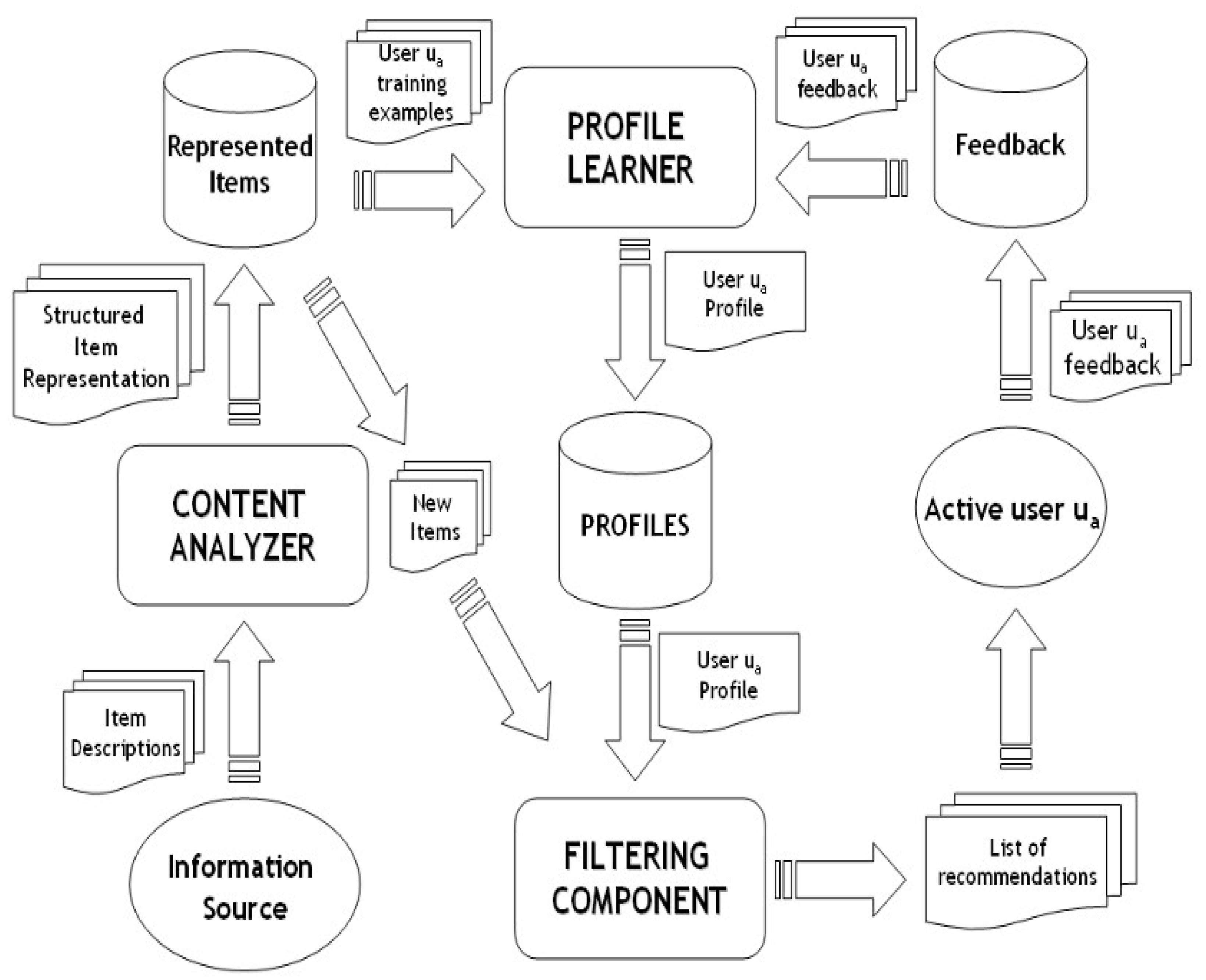
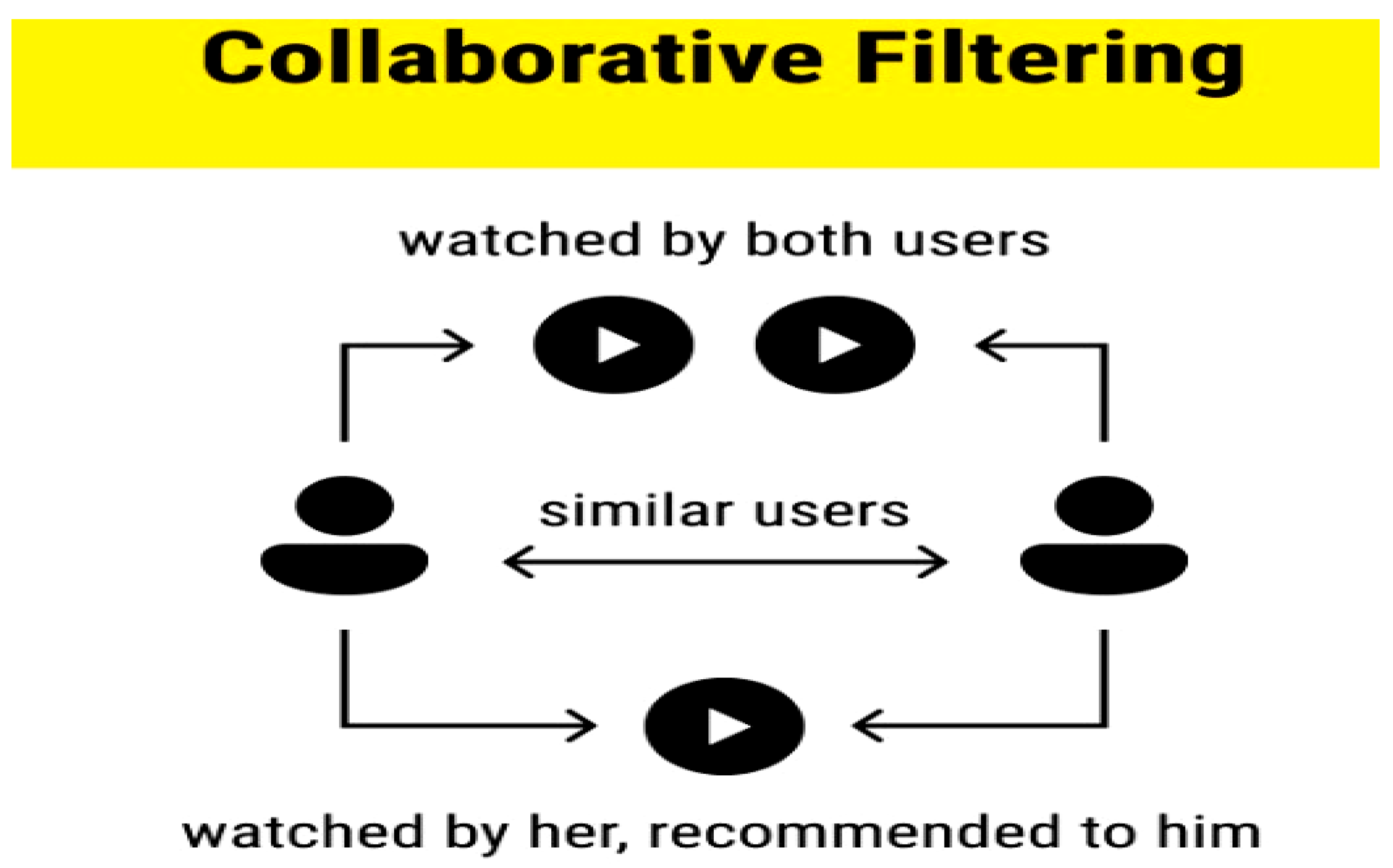
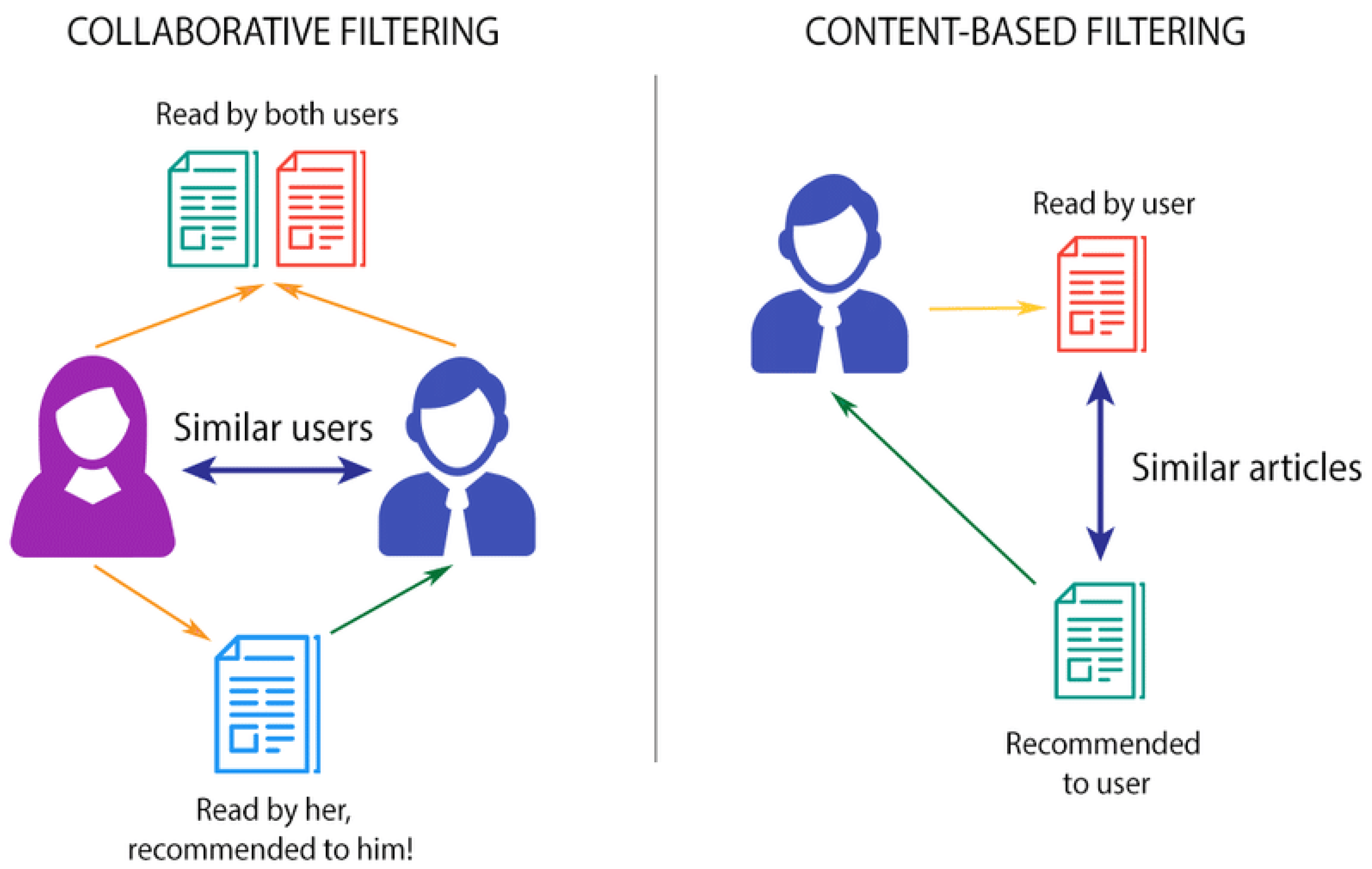
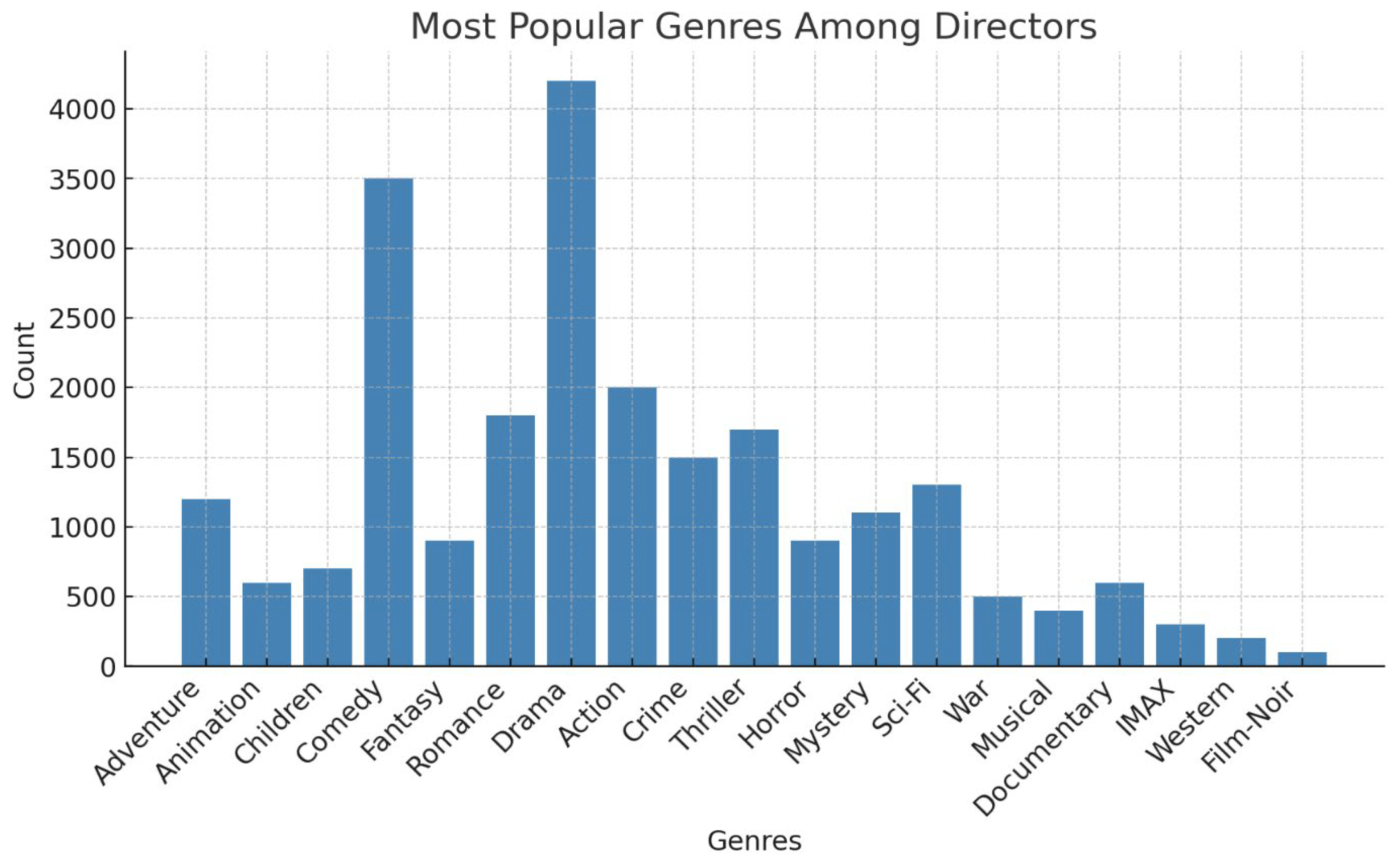
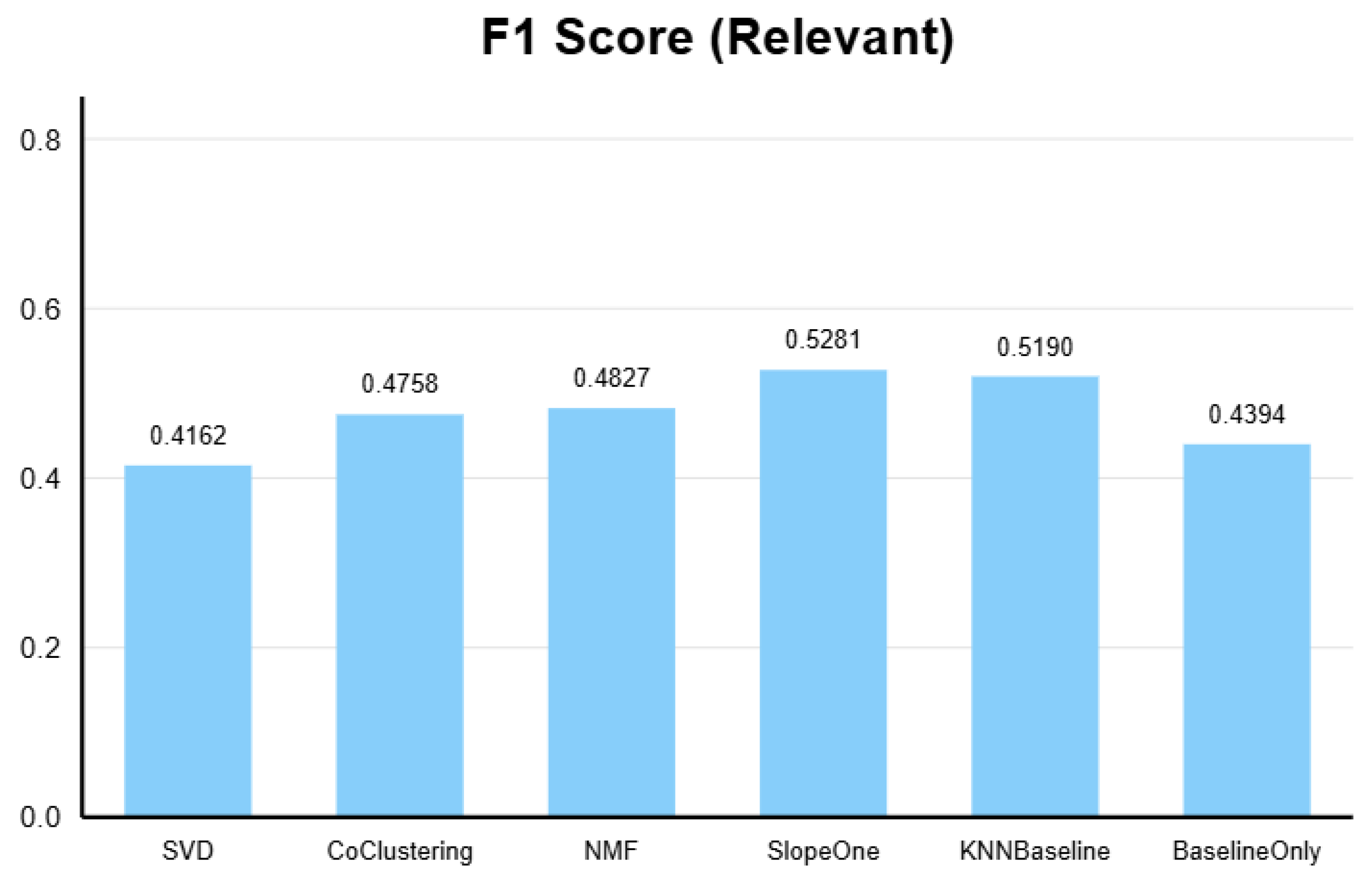
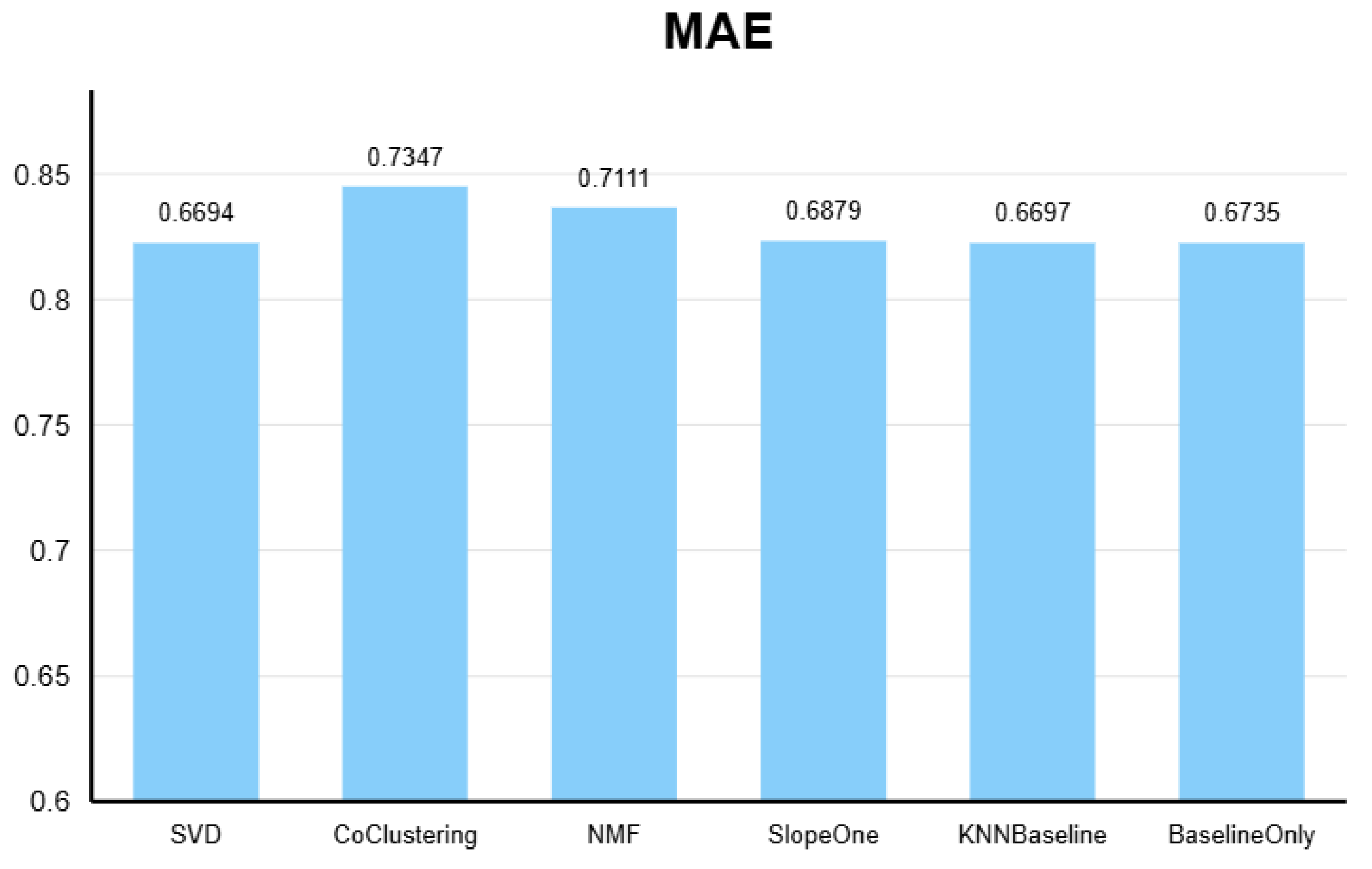
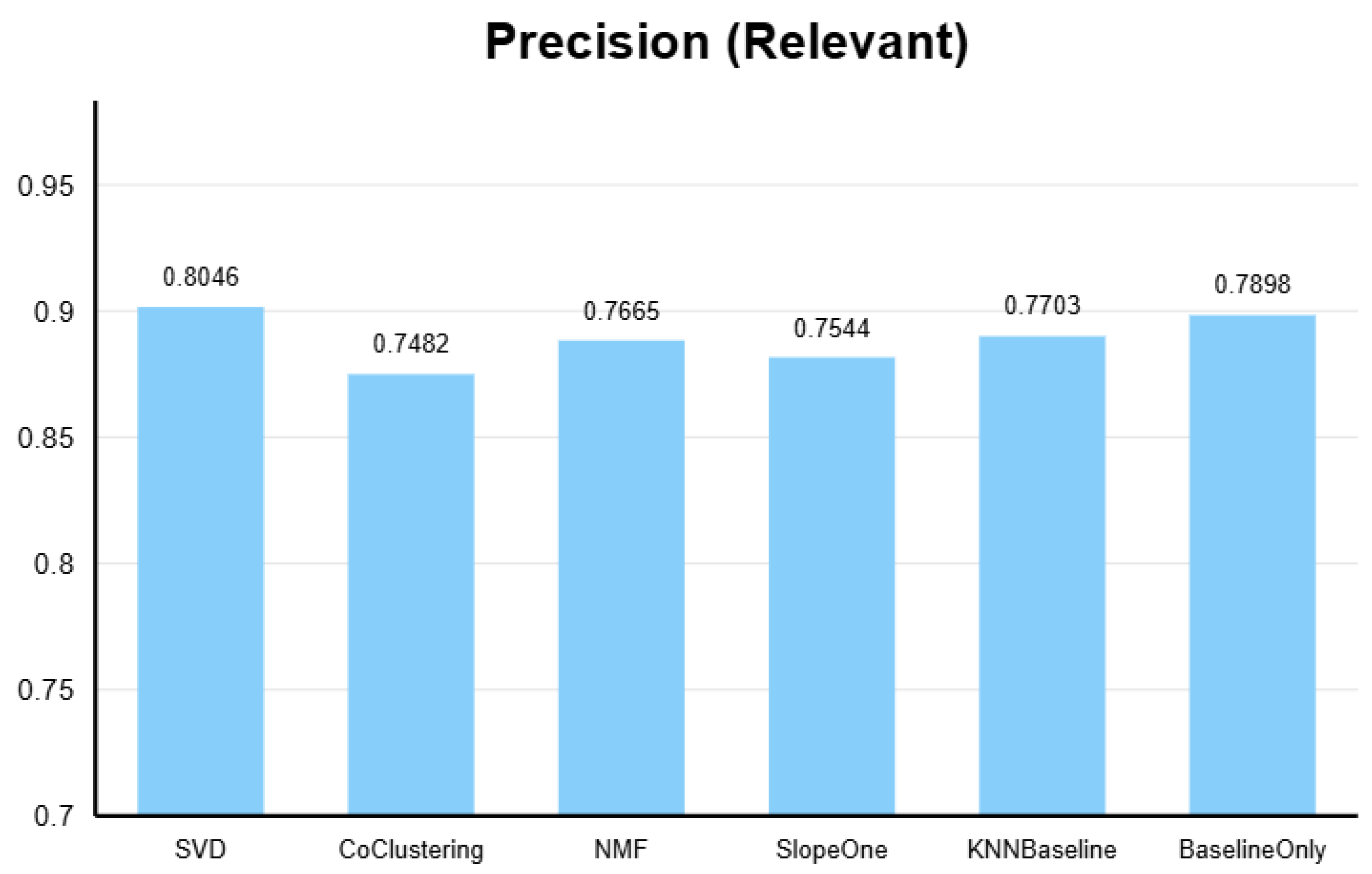

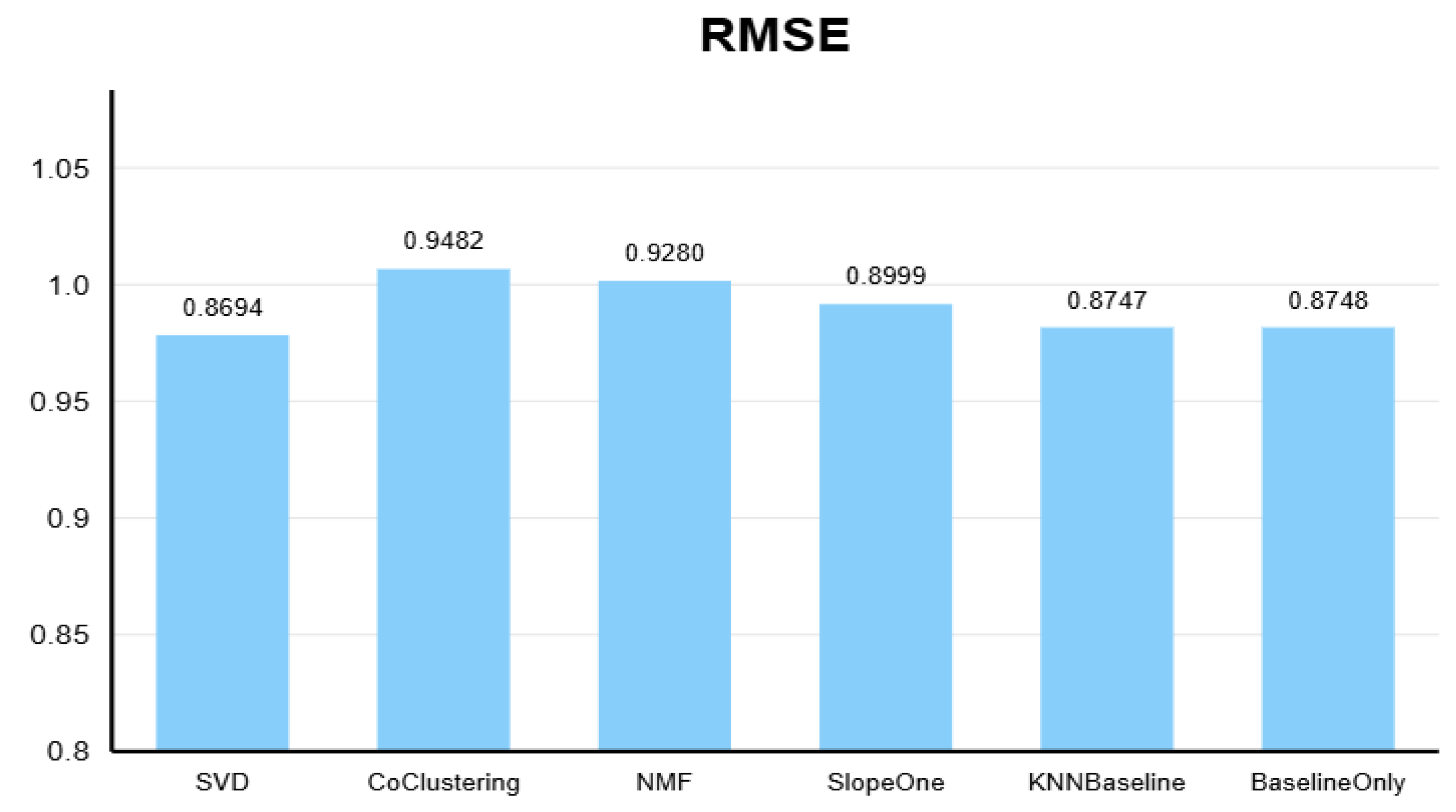
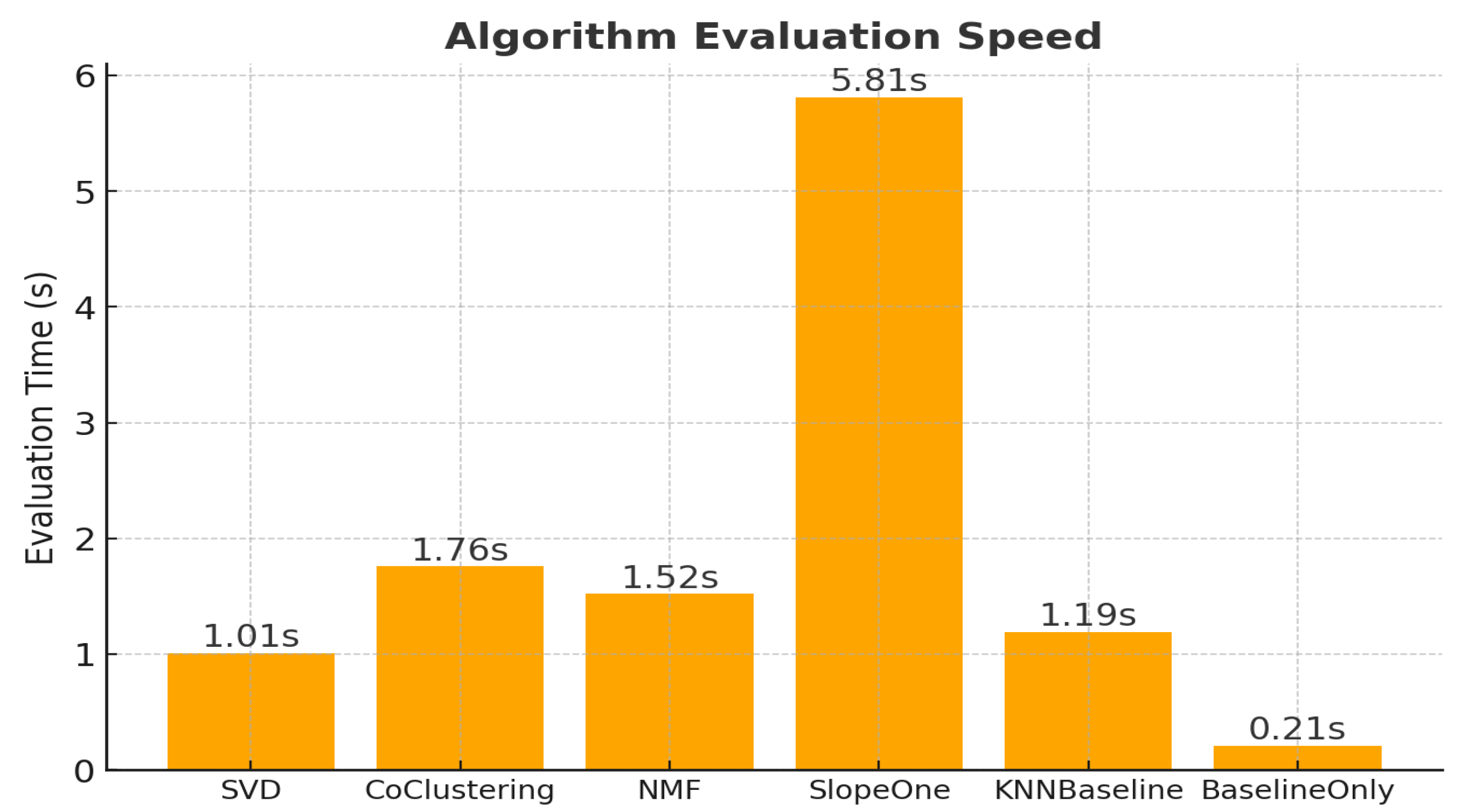
| Algorithms | RMSE | MAE | Precision | Recall | F1 Score | Time |
|---|---|---|---|---|---|---|
| SVD | 0.8633 | 0.6680 | 0.8275 | 0.3940 | 0.4832 | 0.7019 |
| CoClustering | 0.9501 | 0.7346 | 0.7876 | 0.3488 | 0.4346 | 1.8854 |
| NMF | 0.9350 | 0.7150 | 0.7824 | 0.3741 | 0.4077 | 1.4731 |
| SlopeOne | 0.9070 | 0.6925 | 0.7823 | 0.3897 | 0.4222 | 6.3382 |
| KNNBaseline | 0.8830 | 0.6744 | 0.7936 | 0.3206 | 0.4254 | 1.1207 |
| BaselineOnly | 0.8795 | 0.6783 | 0.8073 | 0.3379 | 0.4385 | 0.2948 |
| Algorithms | RMSE | MAE | Precision | Recall | F1 Score | Time |
|---|---|---|---|---|---|---|
| SVD | 0.8625 | 0.6711 | 0.8149 | 0.4469 | 0.4967 | 0.5524 |
| CoClustering | 0.9491 | 0.7333 | 0.7642 | 0.3152 | 0.3889 | 1.8820 |
| NMF | 0.9243 | 0.7076 | 0.7744 | 0.3305 | 0.4033 | 1.6180 |
| SlopeOne | 0.9023 | 0.6886 | 0.7899 | 0.3852 | 0.4268 | 6.4808 |
| KNNBaseline | 0.8747 | 0.6694 | 0.7658 | 0.3473 | 0.4300 | 1.1989 |
| BaselineOnly | 0.8700 | 0.6714 | 0.7947 | 0.3469 | 0.4852 | 0.2271 |
| Algorithms | RMSE | MAE | Precision | Recall | F1 Score | Time |
| SVD | 0.8745 | 0.6727 | 0.8077 | 0.2839 | 0.3497 | 0.8724 |
| CoClustering | 0.9461 | 0.7323 | 0.7762 | 0.2132 | 0.2999 | 2.2950 |
| NMF | 0.9223 | 0.7066 | 0.7644 | 0.2275 | 0.3233 | 1.8180 |
| SlopeOne | 0.9023 | 0.6896 | 0.7539 | 0.2152 | 0.2938 | 3.2808 |
| KNNBaseline | 0.8757 | 0.6694 | 0.7758 | 0.2393 | 0.3080 | 1.3589 |
| BaselineOnly | 0.8720 | 0.6734 | 0.7839 | 0.2603 | 0.3062 | 0.1871 |
| Algorithms | RMSE | MAE | Precision | Recall | F1 Score | Time |
|---|---|---|---|---|---|---|
| Mean | Mean | Mean | Mean | Mean | Mean | |
| SVD | 0.8656 | 0.6720 | 0.8128 | 0.3686 | 0.4014 | 0.7040 |
| CoClustering | 0.9316 | 0.7330 | 0.7717 | 0.3313 | 0.3787 | 1.9205 |
| NMF | 0.9814 | 0.7554 | 0.7557 | 0.3343 | 0.3685 | 1.5209 |
| SlopeOne | 0.9119 | 0.7026 | 0.7728 | 0.3516 | 0.3795 | 6.0221 |
| KNNBaseline | 0.8966 | 0.7072 | 0.7891 | 0.3153 | 0.3511 | 1.1523 |
| BaselineOnly | 0.8767 | 0.6760 | 0.7929 | 0.35312 | 0.3987 | 0.2781 |
Disclaimer/Publisher’s Note: The statements, opinions and data contained in all publications are solely those of the individual author(s) and contributor(s) and not of MDPI and/or the editor(s). MDPI and/or the editor(s) disclaim responsibility for any injury to people or property resulting from any ideas, methods, instructions or products referred to in the content. |
© 2025 by the authors. Licensee MDPI, Basel, Switzerland. This article is an open access article distributed under the terms and conditions of the Creative Commons Attribution (CC BY) license (https://creativecommons.org/licenses/by/4.0/).
Share and Cite
Walek, B.; Sládek, O. Comparison of Selected Algorithms in Movie Recommender System. Appl. Sci. 2025, 15, 9518. https://doi.org/10.3390/app15179518
Walek B, Sládek O. Comparison of Selected Algorithms in Movie Recommender System. Applied Sciences. 2025; 15(17):9518. https://doi.org/10.3390/app15179518
Chicago/Turabian StyleWalek, Bogdan, and Ondřej Sládek. 2025. "Comparison of Selected Algorithms in Movie Recommender System" Applied Sciences 15, no. 17: 9518. https://doi.org/10.3390/app15179518
APA StyleWalek, B., & Sládek, O. (2025). Comparison of Selected Algorithms in Movie Recommender System. Applied Sciences, 15(17), 9518. https://doi.org/10.3390/app15179518






